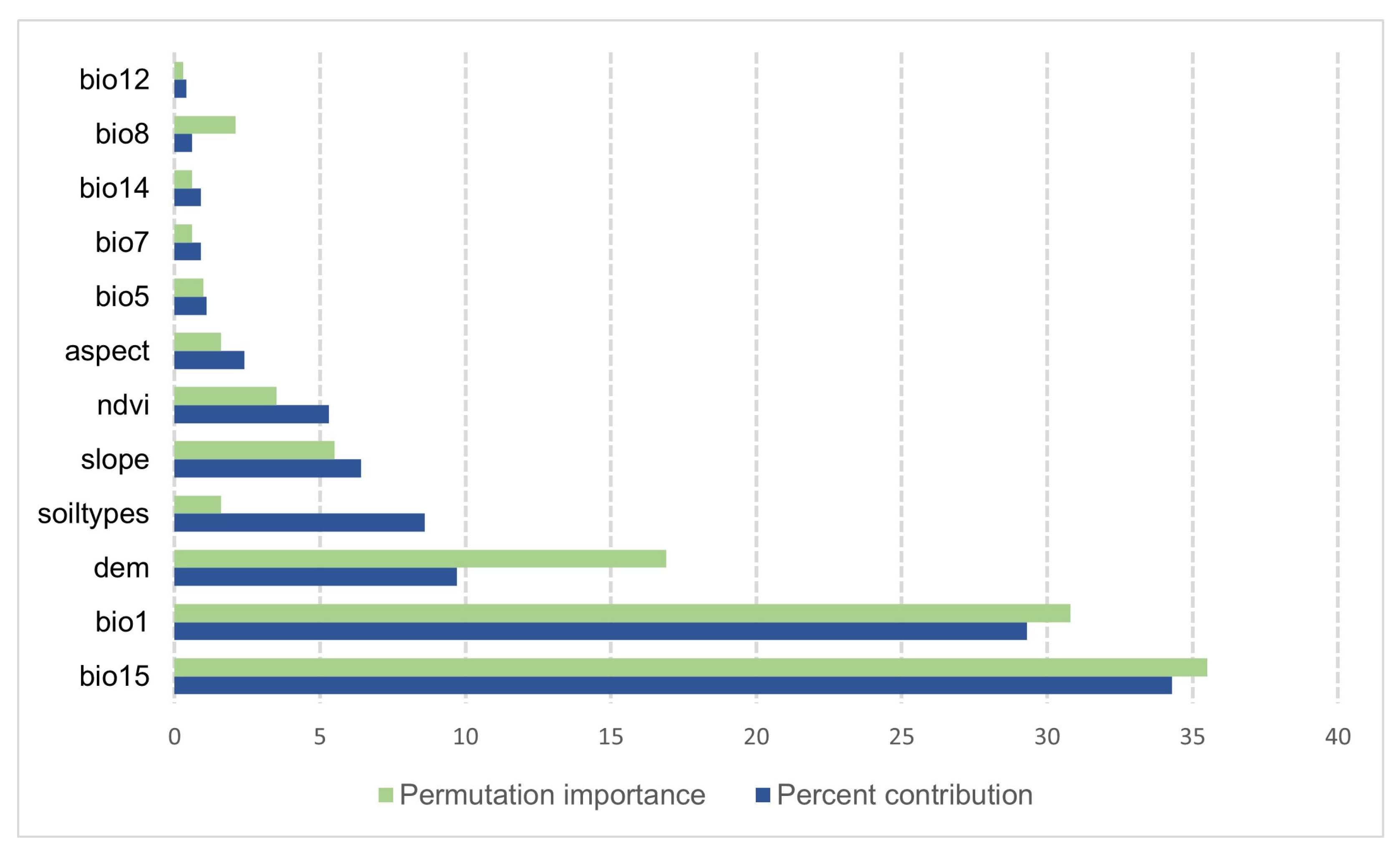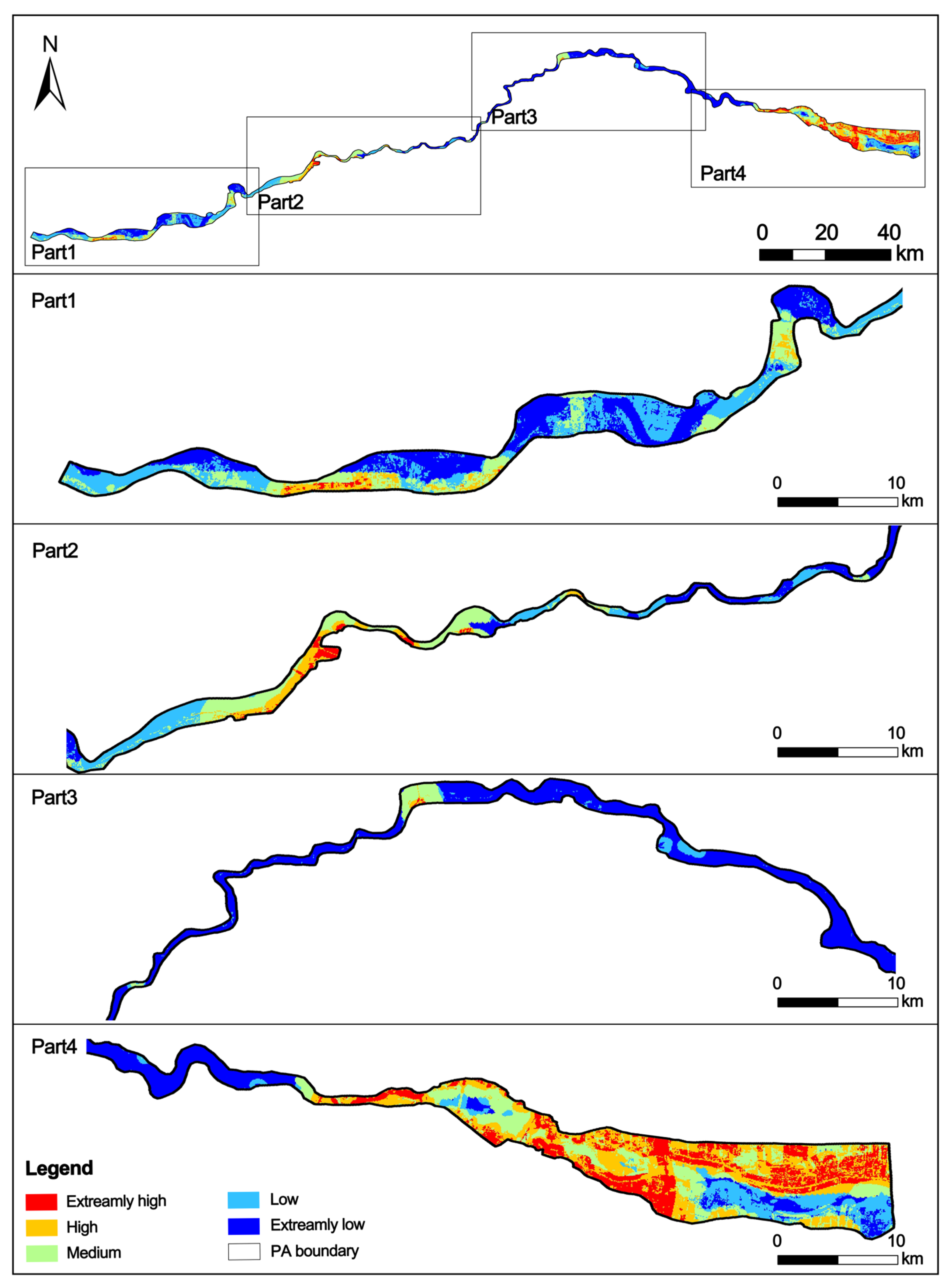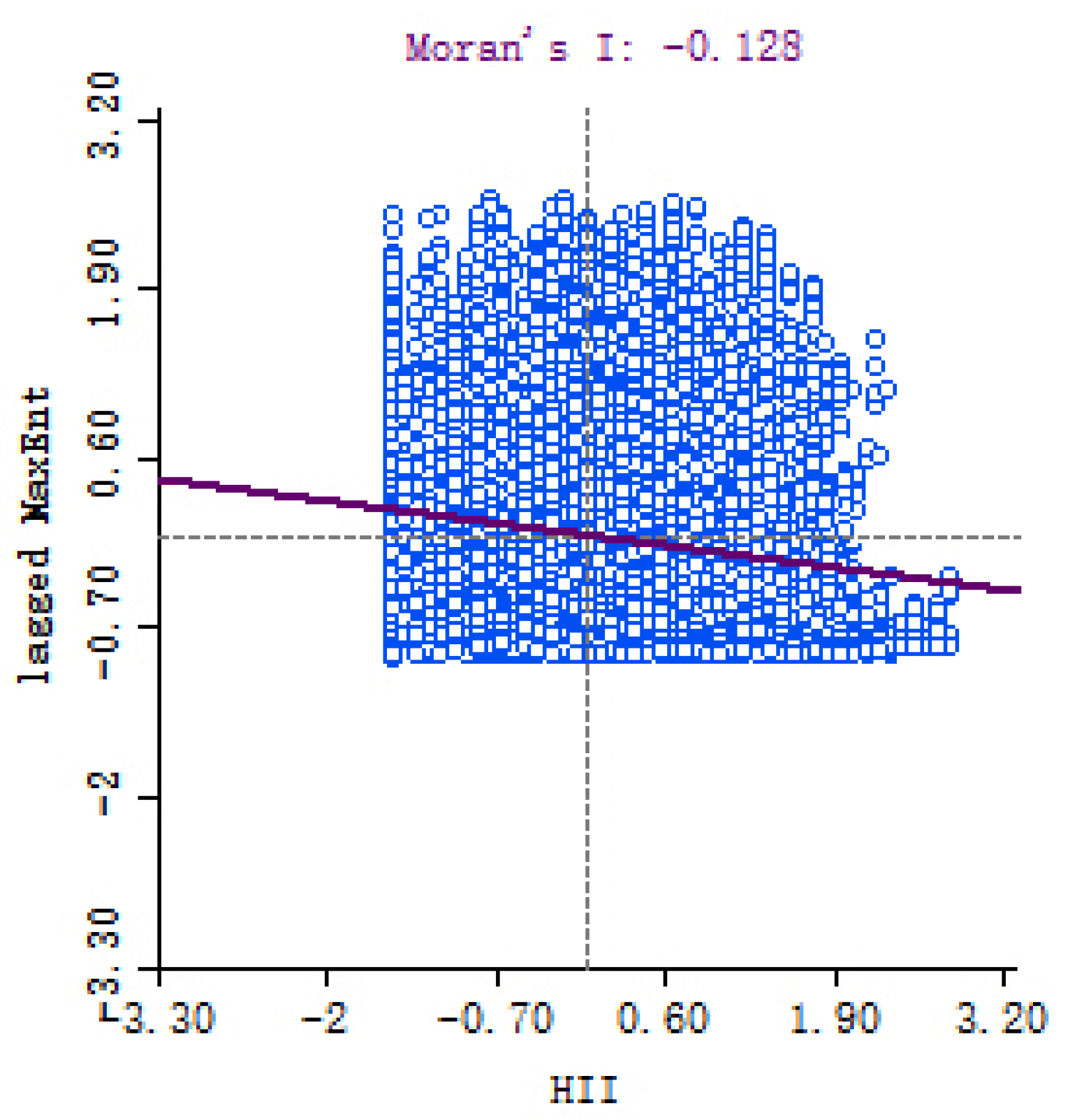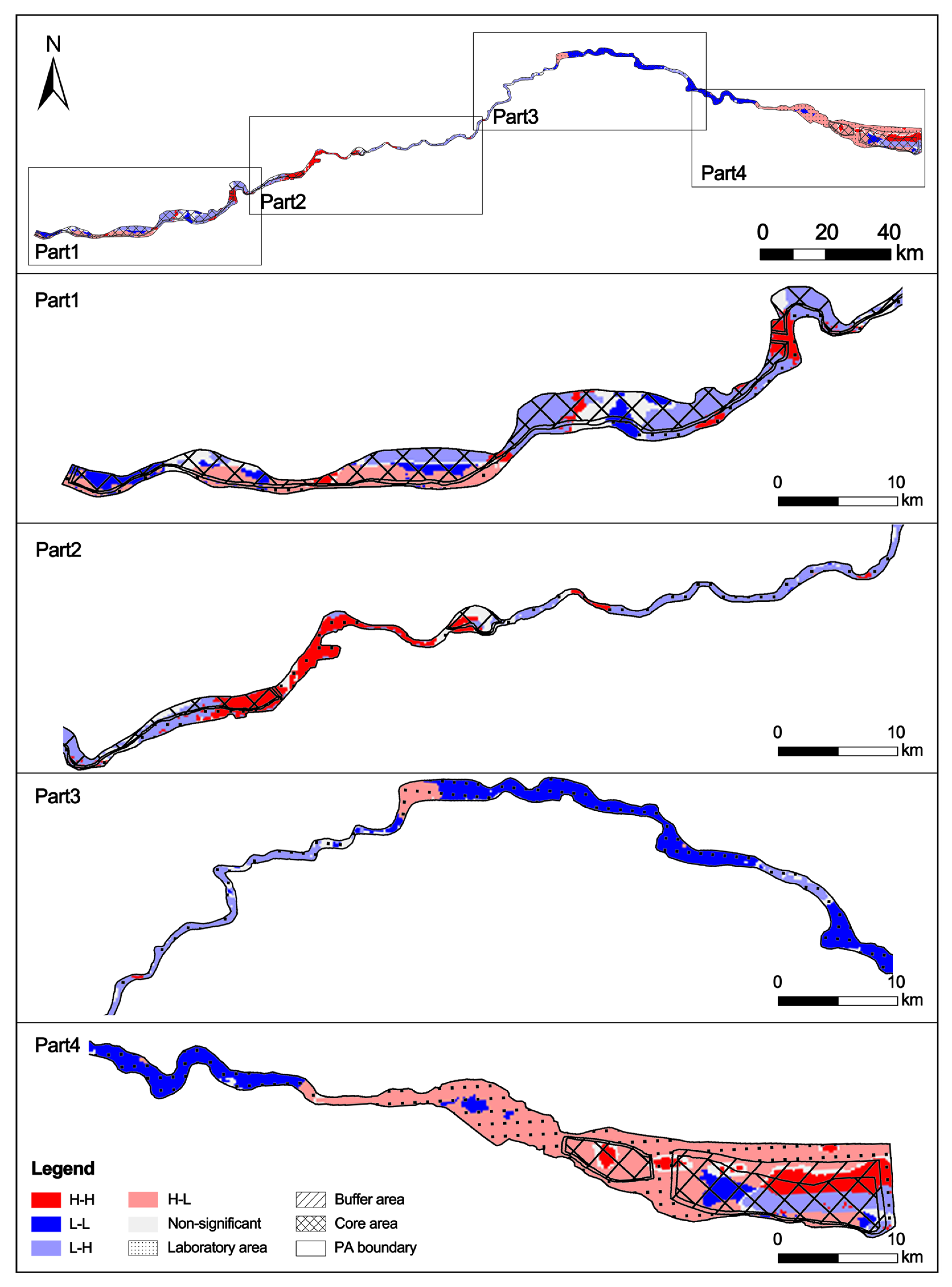Coupling Biodiversity and Human Pressures to Indicate Conservation Priorities for Threatened Waterfowl Species: A Case in the Henan Yellow River Wetland National Nature Reserve
Abstract
1. Introduction
2. Materials and Methods
2.1. Study Area
2.2. Methodological Framework
2.3. MaxEnt Prediction
2.3.1. Avifauna
2.3.2. Environmental Variables
2.3.3. Model Operation and Validation
2.4. Anthropogenic Pressure Assessment
2.4.1. Anthropogenic Pressure Data
2.4.2. Anthropogenic Pressure Assessment
2.5. Conservation Prioritization
3. Results
3.1. Waterfowl Species Distribution
3.2. Human Influence Index
3.3. Bivariate Spatial Autocorrelation Analysis
3.4. Identification of Conservation Gaps
4. Discussion
4.1. Significance of the Framework
4.2. Driving Factors for Threatened Waterfowl Distribution
4.3. Management Suggestions
4.4. Strengths and Limitations of the Study
5. Conclusions
Supplementary Materials
Author Contributions
Funding
Data Availability Statement
Acknowledgments
Conflicts of Interest
References
- Junk, W.J.; An, S.; Finlayson, C.M.; Gopal, B.; Květ, J.; Mitchell, S.A.; Mitsch, W.J.; Robarts, R.D. Current state of knowledge regarding the world’s wetlands and their future under global climate change: A synthesis. Aquat. Sci. 2013, 75, 151–167. [Google Scholar] [CrossRef]
- Fluet-Chouinard, E.; Stocker, B.D.; Zhang, Z.; Malhotra, A.; Melton, J.R.; Poulter, B.; Kaplan, J.O.; Goldewijk, K.K.; Siebert, S.; Minayeva, T.; et al. Extensive global wetland loss over the past three centuries. Nature 2023, 614, 281–286. [Google Scholar] [CrossRef] [PubMed]
- Mammides, C. A global assessment of the human pressure on the world’s lakes. Glob. Environ. Chang. 2020, 63, 102084. [Google Scholar] [CrossRef]
- Rosenberg, K.V.; Dokter, A.M.; Blancher, P.J.; Sauer, J.R.; Smith, A.C.; Smith, P.A.; Stanton, J.C.; Panjabi, A.; Helft, L.; Parr, M.; et al. Decline of the North American avifauna. Science 2019, 366, 120–124. [Google Scholar] [CrossRef]
- Collen, B.; Whitton, F.; Dyer, E.E.; Baillie, J.E.M.; Cumberlidge, N.; Darwall, W.R.T.; Pollock, C.; Richman, N.I.; Soulsby, A.-M.; Böhm, M. Global patterns of freshwater species diversity, threat and endemism. Glob. Ecol. Biogeogr. 2014, 23, 40–51. [Google Scholar] [CrossRef] [PubMed]
- Tickner, D.; Opperman, J.J.; Abell, R.; Acreman, M.; Arthington, A.H.; Bunn, S.E.; Cooke, S.J.; Dalton, J.; Darwall, W.; Edwards, G.; et al. Bending the Curve of Global Freshwater Biodiversity Loss: An Emergency Recovery Plan. BioScience 2020, 70, 330–342. [Google Scholar] [CrossRef] [PubMed]
- Lu, M.; Zou, Y.; Xun, Q.; Yu, Z.; Jiang, M.; Sheng, L.; Lu, X.; Wang, D. Anthropogenic disturbances caused declines in the wetland area and carbon pool in China during the last four decades. Glob. Chang. Biol. 2021, 27, 3837–3845. [Google Scholar] [CrossRef]
- Watson, J.E.M.; Dudley, N.; Segan, D.B.; Hockings, M. The performance and potential of protected areas. Nature 2014, 515, 67–73. [Google Scholar] [CrossRef]
- Barocas, A.; Tobler, M.W.; Abanto Valladares, N.; Alarcon Pardo, A.; Macdonald, D.W.; Swaisgood, R.R. Protected areas maintain neotropical freshwater bird biodiversity in the face of human activity. Ecol. Indic. 2023, 150, 110256. [Google Scholar] [CrossRef]
- Hermoso, V.; Carvalho, S.B.; Giakoumi, S.; Goldsborough, D.; Katsanevakis, S.; Leontiou, S.; Markantonatou, V.; Rumes, B.; Vogiatzakis, I.N.; Yates, K.L. The EU Biodiversity Strategy for 2030: Opportunities and challenges on the path towards biodiversity recovery. Environ. Sci. Policy 2022, 127, 263–271. [Google Scholar] [CrossRef]
- Geldmann, J.; Manica, A.; Burgess, N.D.; Coad, L.; Balmford, A. A global-level assessment of the effectiveness of protected areas at resisting anthropogenic pressures. Proc. Natl. Acad. Sci. USA 2019, 116, 23209–23215. [Google Scholar] [CrossRef] [PubMed]
- Chen, H.; Zhang, T.; Costanza, R.; Kubiszewski, I. Review of the approaches for assessing protected areas’ effectiveness. Environ. Impact Assess. Rev. 2023, 98, 106929. [Google Scholar] [CrossRef]
- Wauchope, H.S.; Jones, J.P.G.; Geldmann, J.; Simmons, B.I.; Amano, T.; Blanco, D.E.; Fuller, R.A.; Johnston, A.; Langendoen, T.; Mundkur, T.; et al. Protected areas have a mixed impact on waterbirds, but management helps. Nature 2022, 605, 103–107. [Google Scholar] [CrossRef] [PubMed]
- Zhang, L.; Ouyang, Z. Focusing on rapid urbanization areas can control the rapid loss of migratory water bird habitats in China. Glob. Ecol. Conserv. 2019, 20, e00801. [Google Scholar] [CrossRef]
- McDuie, F.; Lorenz, A.A.; Klinger, R.C.; Overton, C.T.; Feldheim, C.L.; Ackerman, J.T.; Casazza, M.L. Informing wetland management with waterfowl movement and sanctuary use responses to human-induced disturbance. J. Environ. Manag. 2021, 297, 113170. [Google Scholar] [CrossRef]
- Sun, X.; Shen, J.; Xiao, Y.; Li, S.; Cao, M. Habitat suitability and potential biological corridors for waterbirds in Yancheng coastal wetland of China. Ecol. Indic. 2023, 148, 110090. [Google Scholar] [CrossRef]
- Wang, C.; Liu, H.; Li, Y.; Dong, B.; Qiu, C.; Yang, J.; Zong, Y.; Chen, H.; Zhao, Y.; Zhang, Y. Study on habitat suitability and environmental variable thresholds of rare waterbirds. Sci. Total Environ. 2021, 785, 147316. [Google Scholar] [CrossRef]
- Wang, C.; Zhou, Y.; Zhang, H.; Li, Y.; Liu, H.; Dong, B. Study on the rare waterbird habitat networks of a new UNESCO World Natural Heritage site based on scenario simulation. Sci. Total Environ. 2022, 843, 157058. [Google Scholar] [CrossRef]
- Kim, J.H.; Park, S.; Kim, S.H.; Lee, E.J. Identifying high-priority conservation areas for endangered waterbirds using a flagship species in the Korean DMZ. Ecol. Eng. 2021, 159, 106080. [Google Scholar] [CrossRef]
- Holopainen, S.; Čehovská, M.; Jaatinen, K.; Laaksonen, T.; Lindén, A.; Nummi, P.; Piha, M.; Pöysä, H.; Toivanen, T.; Väänänen, V.-M.; et al. A rapid increase of large-sized waterfowl does not explain the population declines of small-sized waterbird at their breeding sites. Glob. Ecol. Conserv. 2022, 36, e02144. [Google Scholar] [CrossRef]
- Barnes, A.E.; Davies, J.G.; Martay, B.; Boersch-Supan, P.H.; Harris, S.J.; Noble, D.G.; Pearce-Higgins, J.W.; Robinson, R.A. Rare and declining bird species benefit most from designating protected areas for conservation in the UK. Nat. Ecol. Evol. 2023, 7, 92–101. [Google Scholar] [CrossRef] [PubMed]
- Marolla, F.; Aarvak, T.; Hamel, S.; Ims, R.A.; Kéry, M.; Mellard, J.P.; Nater, C.R.; Schaub, M.; Vougioukalou, M.; Yoccoz, N.G.; et al. Life-cycle analysis of an endangered migratory goose to assess the impact of conservation actions on population recovery. Biol. Conserv. 2023, 281, 110028. [Google Scholar] [CrossRef]
- El-Gabbas, A.; Gilbert, F.; Dormann, C.F. Spatial conservation prioritisation in data-poor countries: A quantitative sensitivity analysis using multiple taxa. BMC Ecol. 2020, 20, 35. [Google Scholar] [CrossRef]
- De Silva, S. Need for longitudinal studies of Asian wildlife in the face of crises. Glob. Ecol. Conserv. 2016, 6, 276–285. [Google Scholar] [CrossRef]
- Sun, X.; Liu, W.; Li, S.; Chen, P.; Cao, M.; Randhir, T.O.; Zhang, Y. Species richness patterns of waterbirds overwintering on the Jiangsu coast for coastal reclamation. Ocean Coast. Manag. 2021, 205, 105488. [Google Scholar] [CrossRef]
- Zhao, Q.; Boomer, G.S.; Kendall, W.L. The non-linear, interactive effects of population density and climate drive the geographical patterns of waterfowl survival. Biol. Conserv. 2018, 221, 1–9. [Google Scholar] [CrossRef]
- Xu, Y.; Si, Y.; Yin, S.; Zhang, W.; Grishchenko, M.; Prins, H.H.T.; Gong, P.; de Boer, W.F. Species-dependent effects of habitat degradation in relation to seasonal distribution of migratory waterfowl in the East Asian–Australasian Flyway. Landsc. Ecol. 2019, 34, 243–257. [Google Scholar] [CrossRef]
- Kahara, S.N.; Skalos, D.; Madurapperuma, B.; Hernandez, K. Habitat quality and drought effects on breeding mallard and other waterfowl populations in California, USA. J. Wildl. Manag. 2022, 86, e22133. [Google Scholar] [CrossRef]
- Zhang, W.; Li, X.; Yu, L.; Si, Y. Multi-scale habitat selection by two declining East Asian waterfowl species at their core spring stopover area. Ecol. Indic. 2018, 87, 127–135. [Google Scholar] [CrossRef]
- Timmers, R.; van Kuijk, M.; Verweij, P.A.; Ghazoul, J.; Hautier, Y.; Laurance, W.F.; Arriaga-Weiss, S.L.; Askins, R.A.; Battisti, C.; Berg, Å.; et al. Conservation of birds in fragmented landscapes requires protected areas. Front. Ecol. Environ. 2022, 20, 361–369. [Google Scholar] [CrossRef]
- Gao, B.; Gong, P.; Zhang, W.; Yang, J.; Si, Y. Multiscale effects of habitat and surrounding matrices on waterbird diversity in the Yangtze River Floodplain. Landsc. Ecol. 2021, 36, 179–190. [Google Scholar] [CrossRef]
- Shrestha, N.; Xu, X.; Meng, J.; Wang, Z. Vulnerabilities of protected lands in the face of climate and human footprint changes. Nat. Commun. 2021, 12, 1632. [Google Scholar] [CrossRef] [PubMed]
- Xu, W.; Xiao, Y.; Zhang, J.; Yang, W.; Zhang, L.; Hull, V.; Wang, Z.; Zheng, H.; Liu, J.; Polasky, S.; et al. Strengthening protected areas for biodiversity and ecosystem services in China. Proc. Natl. Acad. Sci. USA 2017, 114, 1601–1606. [Google Scholar] [CrossRef] [PubMed]
- Zhang, P.; Li, X.; Yu, Y. Relationship between ecosystem services and farmers’ well-being in the Yellow River Wetland Nature Reserve of China. Ecol. Indic. 2023, 146, 109810. [Google Scholar] [CrossRef]
- Wei, Z.; Jian, Z.; Sun, Y.; Pan, F.; Han, H.; Liu, Q.; Mei, Y. Ecological sustainability and high-quality development of the Yellow River Delta in China based on the improved ecological footprint model. Sci. Rep. 2023, 13, 3821. [Google Scholar] [CrossRef]
- Merow, C.; Smith, M.J.; Silander, J.A., Jr. A practical guide to MaxEnt for modeling species’ distributions: What it does, and why inputs and settings matter. Ecography 2013, 36, 1058–1069. [Google Scholar] [CrossRef]
- Na, X.; Zhou, H.; Zang, S.; Wu, C.; Li, W.; Li, M. Maximum Entropy modeling for habitat suitability assessment of Red-crowned crane. Ecol. Indic. 2018, 91, 439–446. [Google Scholar] [CrossRef]
- Sanderson, E.W.; Jaiteh, M.; Levy, M.A.; Redford, K.H.; Wannebo, A.V.; Woolmer, G. The Human Footprint and the Last of the Wild: The human footprint is a global map of human influence on the land surface, which suggests that human beings are stewards of nature, whether we like it or not. BioScience 2002, 52, 891–904. [Google Scholar] [CrossRef]
- Santangeli, A.; Girardello, M.; Buechley, E.R.; Eklund, J.; Phipps, W.L. Navigating spaces for implementing raptor research and conservation under varying levels of violence and governance in the Global South. Biol. Conserv. 2019, 239, 108212. [Google Scholar] [CrossRef]
- Sokal, R.R.; Thomson, J.D. Applications of Spatial Autocorrelation in Ecology. In Develoments in Numerical Ecology; NATO ASI Series; Springer: Berlin/Heidelberg, Germany, 1987; pp. 431–466. [Google Scholar]
- Samanta, S.; Das, D.; Mandal, S. Diversity, status and guild structure of the avifauna in the Ajodhya Foothills, Baghmundi, Purulia, West Bengal, India. Trop. Ecol. 2022, 64, 211–223. [Google Scholar] [CrossRef]
- Huang, Z.; Bai, Y.; Alatalo, J.M.; Yang, Z. Mapping biodiversity conservation priorities for protected areas: A case study in Xishuangbanna Tropical Area, China. Biol. Conserv. 2020, 249, 108741. [Google Scholar] [CrossRef]
- Li, Y.; Nigh, T. GIS-based prioritization of private land parcels for biodiversity conservation: A case study from the Current and Eleven Point Conservation Opportunity Areas, Missouri. Appl. Geogr. 2011, 31, 98–107. [Google Scholar] [CrossRef]
- Yackulic, C.B.; Chandler, R.; Zipkin, E.F.; Royle, J.A.; Nichols, J.D.; Campbell Grant, E.H.; Veran, S. Presence-only modelling using MAXENT: When can we trust the inferences? Methods Ecol. Evol. 2013, 4, 236–243. [Google Scholar] [CrossRef]
- Li, X.; Anderson, C.J.; Wang, Y.; Lei, G. Waterbird diversity and abundance in response to variations in climate in the Liaohe Estuary, China. Ecol. Indic. 2021, 132, 108286. [Google Scholar] [CrossRef]
- Amano, T.; Székely, T.; Wauchope, H.S.; Sandel, B.; Nagy, S.; Mundkur, T.; Langendoen, T.; Blanco, D.; Michel, N.L.; Sutherland, W.J. Responses of global waterbird populations to climate change vary with latitude. Nat. Clim. Chang. 2020, 10, 959–964. [Google Scholar] [CrossRef]
- Withey, P.; van Kooten, G.C. The effect of climate change on optimal wetlands and waterfowl management in Western Canada. Ecol. Econ. 2011, 70, 798–805. [Google Scholar] [CrossRef]
- Amatulli, G.; Domisch, S.; Tuanmu, M.-N.; Parmentier, B.; Ranipeta, A.; Malczyk, J.; Jetz, W. A suite of global, cross-scale topographic variables for environmental and biodiversity modeling. Sci. Data 2018, 5, 180040. [Google Scholar] [CrossRef] [PubMed]
- Lin, J.; Li, H.; Zeng, Y.; He, X.; Zhuang, Y.; Liang, Y.; Lu, S. Estimating potential illegal land development in conservation areas based on a presence-only model. J. Environ. Manag. 2022, 321, 115994. [Google Scholar] [CrossRef]
- Tamiminia, H.; Salehi, B.; Mahdianpari, M.; Quackenbush, L.; Adeli, S.; Brisco, B. Google Earth Engine for geo-big data applications: A meta-analysis and systematic review. ISPRS J. Photogramm. Remote Sens. 2020, 164, 152–170. [Google Scholar] [CrossRef]
- De Oliveira, M.L.; Peres, P.H.d.F.; Grotta-Neto, F.; Vogliotti, A.; Passos, F.d.C.; Duarte, J.M.B. Using niche modelling and human influence index to indicate conservation priorities for Atlantic forest deer species. J. Nat. Conserv. 2022, 69, 126262. [Google Scholar] [CrossRef]
- Ver Hoef, J.M.; Peterson, E.E.; Hooten, M.B.; Hanks, E.M.; Fortin, M.-J. Spatial autoregressive models for statistical inference from ecological data. Ecol. Monogr. 2018, 88, 36–59. [Google Scholar] [CrossRef]
- Lee, S.-I. Developing a bivariate spatial association measure: An integration of Pearson’s r and Moran’s I. J. Geogr. Syst. 2001, 3, 369–385. [Google Scholar] [CrossRef]
- Huang, L.; Wang, J.; Chen, X. Ecological infrastructure planning of large river basin to promote nature conservation and ecosystem functions. J. Environ. Manag. 2022, 306, 114482. [Google Scholar] [CrossRef]
- Kang, J.; Li, C.; Li, M.; Zhang, T.; Zhang, B. Identifying priority areas for conservation in the lower Yellow River basin from an ecological network perspective. Ecosyst. Health Sustain. 2022, 8, 2105751. [Google Scholar] [CrossRef]
- Yi, S.; Wu, P.; Peng, X.; Tang, Z.; Bai, F.; Sun, X.; Gao, Y.; Qin, H.; Yu, X.; Wang, R.; et al. Biodiversity, environmental context and structural attributes as drivers of aboveground biomass in shrublands at the middle and lower reaches of the Yellow River basin. Sci. Total Environ. 2021, 774, 145198. [Google Scholar] [CrossRef] [PubMed]
- Blake-Bradshaw, A.G.; Lancaster, J.D.; O’Connell, J.R.; Matthews, J.W.; Eichholz, M.W.; Hagy, H.M. Suitability of Wetlands for Migrating and Breeding Waterbirds in Illinois. Wetlands 2020, 40, 1993–2010. [Google Scholar] [CrossRef]
- Poiani, K.A.; Johnson, W.C.; Kittel, T.G.F. Sensitivity of a prairie wetland to increased temperature and seasonal precipitation changes. JAWRA J. Am. Water Resour. Assoc. 1995, 31, 283–294. [Google Scholar] [CrossRef]
- Rahbek, C.; Gotelli, N.J.; Colwell, R.K.; Entsminger, G.L.; Rangel, T.F.L.V.B.; Graves, G.R. Predicting continental-scale patterns of bird species richness with spatially explicit models. Proc. R. Soc. B Biol. Sci. 2006, 274, 165–174. [Google Scholar] [CrossRef] [PubMed]
- Casazza, M.L.; McDuie, F.; Jones, S.; Lorenz, A.A.; Overton, C.T.; Yee, J.; Feldheim, C.L.; Ackerman, J.T.; Thorne, K.M. Waterfowl use of wetland habitats informs wetland restoration designs for multi-species benefits. J. Appl. Ecol. 2021, 58, 1910–1920. [Google Scholar] [CrossRef]
- Ma, Z.; Cai, Y.; Li, B.; Chen, J. Managing Wetland Habitats for Waterbirds: An International Perspective. Wetlands 2010, 30, 15–27. [Google Scholar] [CrossRef]
- Stokes, A.; Angeles, G.; Anthelme, F.; Aranda-Delgado, E.; Barois, I.; Bounous, M.; Cruz-Maldonado, N.; Decaëns, T.; Fourtier, S.; Freschet, G.T.; et al. Shifts in soil and plant functional diversity along an altitudinal gradient in the French Alps. BMC Res. Notes 2021, 14, 54. [Google Scholar] [CrossRef] [PubMed]
- Bhandari, J.; Zhang, Y. Effect of altitude and soil properties on biomass and plant richness in the grasslands of Tibet, China, and Manang District, Nepal. Ecosphere 2019, 10, e02915. [Google Scholar] [CrossRef]
- Sordello, R.; Busson, S.; Cornuau, J.H.; Deverchère, P.; Faure, B.; Guetté, A.; Hölker, F.; Kerbiriou, C.; Lengagne, T.; Le Viol, I.; et al. A plea for a worldwide development of dark infrastructure for biodiversity—Practical examples and ways to go forward. Landsc. Urban Plan. 2022, 219, 104332. [Google Scholar] [CrossRef]
- Cooke, S.C.; Balmford, A.; Donald, P.F.; Newson, S.E.; Johnston, A. Roads as a contributor to landscape-scale variation in bird communities. Nat. Commun. 2020, 11, 3125. [Google Scholar] [CrossRef]
- Gagné, S.A.; Sherman, P.J.; Singh, K.K.; Meentemeyer, R.K. The effect of human population size on the breeding bird diversity of urban regions. Biodivers. Conserv. 2016, 25, 653–671. [Google Scholar] [CrossRef]
- Latta, S.C.; Musher, L.J.; Latta, K.N.; Katzner, T.E. Influence of human population size and the built environment on avian assemblages in urban green spaces. Urban Ecosyst. 2013, 16, 463–479. [Google Scholar] [CrossRef]









| Variables | Indicators | Period | Data Sources | Data Processing |
|---|---|---|---|---|
| Meteorological factors | Bio1, Bio5, Bio7, Bio8, Bio12, Bio14, Bio15 | 2020 | WorldClim (https://worldclim.org/ (accessed on 7 May 2022)) | Random value points were extracted and then interpolated to 30″ (~1 km grid cell) resolution |
| Topographical factors | Altitude, Slope, Aspect | 2020 | Google Earth Engine (https://www.earthengine.google.com/ (accessed on 10 May 2022)) | Clipped after downloading and kept at their native resolution of 30 m |
| Vegetation | Normalized Difference Vegetation Index (NDVI) | 2020 | Resource and Environmental Science and Data Center (https://www.resdc.cn/ (accessed on 12 May 2022)) | Calculated from red and near-infrared (NIR) values as: (rNIR − rRed)/(rNIR + rRed); combined with LULC database |
| Soil | Soil type | 2020 | Resource and Environmental Science and Data Center (https://www.resdc.cn/ (accessed on 13 May 2022)) | Clipped after downloading and kept at their native resolution of 30 m |
| Data | Period | Data Form | Data Resolution | Data Source |
|---|---|---|---|---|
| LULC | 2020 | Grid | 10 m | Google Earth Engine (https://earthengine.google.com/ (accessed on 13 June 2022)) |
| NPP/VIIRS nighttime light data | 2021 | Grid | 500 m | Colorado University of Mining (https://eogdata.mines.edu/products/vnl/ (accessed on 16 June 2022)) |
| Population density | 2021 | Grid | 100 m | Worldpop (https://worldpop.Ldpop.org/ (accessed on 18 June 2022)) |
| Road traffic data | 2020 | Vector | Open Street Map (https://www.Openstreemap.org/ (accessed on 2 June 2022)) |
| Variable | Coefficient | Std. Error | z-Value | Probability |
|---|---|---|---|---|
| CONSTANT | −0.00842 | 0.001151 | −7.31062 | 0.00000 |
| Nightlight | −0.00021 | 0.000143 | −1.44922 | 0.00000 |
| Population density | 0.006357 | 0.000481 | 13.2271 | 0.08257 |
| LULC | −0.003564 | 0.000175 | 20.42 | 0.17428 |
| Traffic accessibility | −0.00133 | 0.000122 | −10.9213 | 0.00000 |
Disclaimer/Publisher’s Note: The statements, opinions and data contained in all publications are solely those of the individual author(s) and contributor(s) and not of MDPI and/or the editor(s). MDPI and/or the editor(s) disclaim responsibility for any injury to people or property resulting from any ideas, methods, instructions or products referred to in the content. |
© 2023 by the authors. Licensee MDPI, Basel, Switzerland. This article is an open access article distributed under the terms and conditions of the Creative Commons Attribution (CC BY) license (https://creativecommons.org/licenses/by/4.0/).
Share and Cite
Cao, Y.; Wang, S.; Tian, G.; Dong, N.; Lei, Y. Coupling Biodiversity and Human Pressures to Indicate Conservation Priorities for Threatened Waterfowl Species: A Case in the Henan Yellow River Wetland National Nature Reserve. Land 2023, 12, 1250. https://doi.org/10.3390/land12061250
Cao Y, Wang S, Tian G, Dong N, Lei Y. Coupling Biodiversity and Human Pressures to Indicate Conservation Priorities for Threatened Waterfowl Species: A Case in the Henan Yellow River Wetland National Nature Reserve. Land. 2023; 12(6):1250. https://doi.org/10.3390/land12061250
Chicago/Turabian StyleCao, Yang, Siyu Wang, Guohang Tian, Nalin Dong, and Yakai Lei. 2023. "Coupling Biodiversity and Human Pressures to Indicate Conservation Priorities for Threatened Waterfowl Species: A Case in the Henan Yellow River Wetland National Nature Reserve" Land 12, no. 6: 1250. https://doi.org/10.3390/land12061250
APA StyleCao, Y., Wang, S., Tian, G., Dong, N., & Lei, Y. (2023). Coupling Biodiversity and Human Pressures to Indicate Conservation Priorities for Threatened Waterfowl Species: A Case in the Henan Yellow River Wetland National Nature Reserve. Land, 12(6), 1250. https://doi.org/10.3390/land12061250










